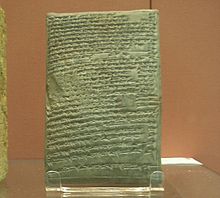- Nabu-shum-libur
-
Nabû-šuma-libūr King of Babylon 
Contract of a sale of land imposed by the need to pay a ransom, dated to his 1st year.Reign 1033 – 1026 BC Predecessor Marduk-zer-X Successor Simbar-Šipak
(Dynasty V)Royal House 2nd Dynasty of Isin Nabû-šuma-libūr (1033 – 1026 BC) was the 11th and last king of the 2nd Dynasty of Isin, the 4th Dynasty of Babylon. He ruled during a period of instability due to incursions of Aramean nomadic tribesmen in Northwest Babylonia.
Contents
Biography
There is very little extant material for his reign. The legal text pictured[i 1] is from his first year. It was found at Kār-Bēlet-Ilāni near Nippur and details the reimbursement of the šandabakku, or governor, of Nippur with land after he ransomed a man from the enemy.[nb 1]
A stone duck weight[i 2] inscribed Nabû-šuma-libūr, optimistically titled šar kiššati (“king of the world”),[nb 2] found its way to the Northwest palace of Nimrud, where it was discovered by Layard in the mid 19th century, and perhaps indicates continued trade.[1] It was marked 30 minas (about 15 kilograms).
Ominous portents dated for his reign are included in a damaged religious chronicle of the Seleucid era.[i 3] It records, “a lion was lying lurking and they killed it,” a prophecy fulfilled by the fall of the dynasty.[2] The events at the end of his reign are not known, but the dynasty was followed by the 2nd Dynasty of Sealand when a substantial part of southern Mesopotamia seceded.
Inscriptions
- ^ Tablet ME 139424, on display in room 55 of the British Museum.
- ^ Alabaster duck-weight with two panels of cuneiform inscription; top of bird's head lost; abraded, BM 91432.
- ^ The Religious Chronicle, tablet BM 35968 (ABC 17) column 1.
Notes
- ^ The “enemy” is recorded as LÚ.KÚR.MEŠ, and is unspecific.
- ^ Transliterated: 30 ma- <na> gl-na [ ] sa dAG. Mu-li-bur LUGAL DIN.[ ], translated: “30 mina, correct, of Nabû-šuma-libūr, king of the world.”
References
Babylonian kings Amorite period
(Middle Bronze Age)First Dynasty of Isinca. 1953 – 1730 BCIshbi-Erra · Shu-ilishu · Iddin-Dagan · Ishme-Dagan · Lipit-Eshtar · Ur-Ninurta · Bur-Suen · Lipit-Enlil · Erra-imitti · Enlil-bani · Zambiya · Iter-pisha · Ur-du-kuga · Suen-magir · Damiq-ilishuKings of Larsaca. 1961 – 1674 BCNaplanum · Emisum · Samium · Zabaia · Gungunum · Abisare · Sumuel · Nur-Adad · Sin-Iddinam · Sin-Eribam · Sin-Iqisham · Silli-Adad · Warad-Sin · Rim-Sin I · Hammurabi (of Babylon) · Samsu-iluna (of Babylon) · Rim-Sin IIMiddle Bronze Age First Babylonian Dynasty
(Dynasty I)ca. 1830 – 1531 BCSumu-abum · Sumu-la-El · Sabium · Apil-Sin · Sin-muballit · Hammurabi · Samsu-iluna · Abi-eshuh · Ammi-ditana · Ammi-saduqa · Samsu-DitanaSealand Dynasty
(Dynasty II)ca. 1732 – 1460 BCIluma-ilum · Itti-ili-nibi · Damiq-ilishu · Ishkibal · Shushushi · Gulkishar · Peshgaldaramash · Adarakalamma · Ekurduanna · Melamkurkukka · (unnamed king) · Ea-gamilEarly Kassite rulersca. 1730 – 1570 BCGandash · Agum I · Kashtiliash I · Ushi · Abirattash · Kashtiliash II · Urzigurumash · Harbashihu · Tiptakzi · AtraLate Bronze Age Kassite Dynasty
(Dynasty III)ca. 1570 – 1155 BCAgum II · Burnaburiash I · Kashtiliash III · Ulamburiash · Agum III · Karaindash · Kadashman-harbe I · Kurigalzu I · Kadashman-Enlil I · Burnaburiash II · Kara-hardash · Nazi-Bugash · Kurigalzu II · Nazi-Maruttash · Kadashman-Turgu · Kadashman-Enlil II · Kudur-Enlil · Shagarakti-Shuriash · Kashtiliashu IV · Enlil-nadin-shumi · Kadashman-Harbe II · Adad-shuma-iddina · Adad-shuma-usur · Meli-Shipak II · Marduk-apla-iddina I · Zababa-shuma-iddin · Enlil-nadin-ahiIron Age Second Dynasty of Isin
(Dynasty IV of Babylon)ca. 1155 – 1025 BCMarduk-kabit-ahheshu · Itti-Marduk-balatu · Ninurta-nadin-shumi · Nebuchadrezzar I · Enlil-nadin-apli · Marduk-nadin-ahhe · Marduk-shapik-zeri · Adad-apla-iddina · Marduk-ahhe-eriba · Marduk-zer-X · Nabu-shum-liburDynasty Vca. 1025 – 1004 BCSimbar-shipak · Ea-mukin-shumi · Kashu-nadinDynasty VIca. 1004 – 985 BCEulma-shakin-shumi · Ninurta-kudurri-usur · Shiriqti-shuqamunuDynasty VIIca. 985 – 979 BCDynasty VIIIca. 979 – 943 BCDynasty IXca. 943 – 729 BCNinurta-kudurri-usur · Mar-biti-ahhe-iddina · Shamash-mudammiq · Nabu-shuma-ukin · Nabu-apla-iddina · Marduk-zakir-shumi I · Marduk-balassu-iqbi · Baba-aha-iddina · (five kings) · Ninurta-apla-X · Marduk-bel-zeri · Marduk-apla-usur · Eriba-Marduk · Nabu-shuma-ishkun · Nabonassar · Nabu-nadin-zeri · Nabu-shuma-ukin II · Nabu-mukin-zeriNeo-Assyrian rule
(Dynasty X)729 – 620 BCTiglath-Pileser III† · Shalmaneser V† · Marduk-apla-iddina II · Sargon II† · Sennacherib† · Marduk-zakir-shumi II · Marduk-apla-iddina II · Bel-ibni · Ashur-nadin-shumi† · Nergal-ushezib · Mushezib-Marduk · Sennacherib† · Esarhaddon† · Shamash-shum-ukin† · Kandalanu† · Sin-shumu-lishir† · Sinsharishkun†Neo-Babylonian Empire
(Dynasty XI)626 – 539 BC† Assyrian rulersCategories:- Babylonian kings
- 11th-century BC deaths
Wikimedia Foundation. 2010.
